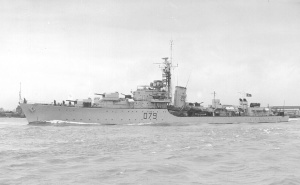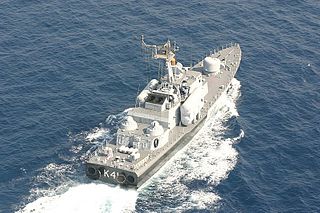
HMS Charity was a C-class destroyer of the Royal Navy laid down by John I. Thornycroft and Company of Woolston, Southampton on 9 July 1943. She was launched on 30 November 1944 and commissioned on 19 November 1945. She was sold to the US Navy in 1958, for transfer to the Pakistan Navy as a part of the Military Aid Program.

HMS Cadiz was a Battle-class destroyer of the Royal Navy. She was named after the Battle of Cádiz, in which the French besieged the Spanish town in 1810, which was eventually lifted in 1812 after the French defeat at the Battle of Salamanca.
Operation Trident was an offensive operation launched by the Indian Navy on Pakistan's port city of Karachi during the Indo-Pakistani War of 1971. Operation Trident saw the first use of anti-ship missiles in combat in the region. The operation was conducted on the night of 4–5 December and inflicted heavy damage on Pakistani vessels and facilities. While India suffered no losses, Pakistan lost a minesweeper, a destroyer, a cargo vessel carrying ammunition, and fuel storage tanks in Karachi. Another destroyer was also badly damaged and eventually scrapped. India celebrates its Navy Day annually on 4 December to mark this operation. Trident was followed up by Operation Python three days later.
Operation Python, a follow-up to Operation Trident, was the code name of a naval attack launched on West Pakistan's port city of Karachi by the Indian Navy during the Indo-Pakistani War of 1971. After the first attack during Operation Trident on the Port of Karachi, Pakistan stepped up aerial surveillance of its coast as the presence of large Indian Navy ships gave the impression that another attack was being planned. Pakistani warships attempted to outsmart the Indian Navy by mingling with merchant shipping. To counter these moves, Operation Python was launched on the night of 8/9 December 1971. A strike group consisting of one missile boat and two frigates attacked the group of ships off the coast of Karachi. While India suffered no losses, Pakistani fleet tanker PNS Dacca was damaged beyond repair, and the Kemari Oil Storage facility was lost. Two other foreign ships stationed in Karachi were also sunk during the attack.

Admiral Sardarilal Mathradas 'Charles' Nanda, PVSM, AVSM was an Indian Navy Admiral who served as the 7th Chief of the Naval Staff from 1 March 1970 until 28 February 1973. He led the Indian Navy during the Indo-Pakistani War of 1971 and successfully executed a naval blockade of both West and East Pakistan, helping India achieve an overwhelming victory during the war. He is one of the most notable commanders in the history of the Indian Navy.

The Veer-class corvettes of the Indian Navy are a customized Indian variant of the Soviet Tarantul class. They form the 22nd Killer Missile Vessel Squadron.
The Vidyut-class missile boats of the Indian Navy were an Indian variant of the Soviet Osa I class.
INS Veer (K82) was a Vidyut class missile boat of the Indian Navy.
INS Vidyut (K83) was the lead vessel of her class of fast attack craft of the Indian Navy.
INS Vijeta (K84) was a Vidyut class missile boat of the Indian Navy.
INS Vinash (K85) was a Vidyut class missile boat of the Indian Navy. She was a member of the 25th Killer Missile Boat Squadron.
INS Nashak (K87) was a Vidyut class missile boat of the Indian Navy.
INS Nirbhik (K88) was a Vidyut class missile boat of the Indian Navy. It was this ship that the first missile launch was done to demonstrate to the then Prime Minister, Defence Minister and other dignitaries. The missile was launched by Lt. G. Sri Rama Rao.
INS Nirghat (K89) was a Vidyut-class missile boat of the Indian Navy.
The Indo-Pakistani Naval War of 1971 refers to the maritime military engagements between the Indian Navy and the Pakistan Navy during the Indo-Pakistani War of 1971. The India–Pakistan hostilities during this time period were a direct result of the Bangladesh Liberation War, which had been ongoing in erstwhile East Pakistan since the Pakistan Army's execution of Operation Searchlight in an effort to curb the Bengali nationalist movement in Pakistan's eastern wing. The series of naval operations began with the Indian Navy's exertion of pressure on Pakistan from the Indian Ocean, while the Indian Army and Indian Air Force moved in to choke Pakistani forces operating in East Pakistan on land. Indian naval operations comprised naval interdiction, air defence, ground support, and logistics missions.
PNS Muhafiz was an Adjutant-class minesweeper of the Pakistan Navy. It was built by the United States for transfer to Pakistan. PNS Muhafiz was sunk by a missile from INS Veer of the Indian Navy during the Indo-Pakistani War of 1971.
INS Nistar was a submarine rescue vessel of the Indian Navy. It was bought from reserve stock of the USSR in 1969 and was commissioned by the Indian Navy in 1971. The ship having a displacement of 800 tonnes had the capability of rescuing the crew of a disabled submarine from deep depths, using a "rescue bell", by the dry escape method, which avoided problems associated with decompression. Nistar was used in December during Indo-Pakistani War of 1971 to locate Pakistan Navy submarine PNS Ghazi, which sank off the port of Vizag.
Lt. Com. Bahadur Nariman KavinaVrC was a prominent Indian naval officer, who was commanding officer of the INS Nipat. During the Indo-Pakistani War of 1971, Kavina was the chief architect of attack on the Port of Karachi and led the successful attack on Pakistani Navy headquarters.

PNS Babur (D-182) was a Tariq-class destroyer that served in the Surface Command of the Pakistan Navy from 1993 until being decommissioned in 2014. Before commissioning in the Pakistan Navy, she served in the Royal Navy, formerly designated as HMS Amazon as a general purpose frigate.

The Western Fleet is a Naval fleet of the Indian Navy. It is known as the 'Sword Arm' of the Indian Navy. It is headquartered at Mumbai, Maharashtra on the west coast of India. It is a part of the Western Naval Command and is responsible for the naval forces in the Arabian Sea and parts of the Indian Ocean.





